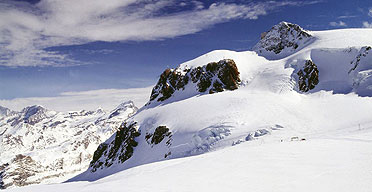Jörg Ruckriegel, head of nature and environment at the German Alpine Association, said: “These plans overstep the mark in every way.”
A Zermatt website has attracted a string of angry responses. Paul Broadley, a British skier, wrote: “Not only would it destroy the very thing people come to Zermatt to see, but it would require an infrastructure … that would make a mockery of Zermatt’s ‘green’ credentials.”
Protesters point to other utopian projects in resorts such as Davos, Laxeralp and Arosa, to show that Klein Matterhorn is part of a wider trend, and talk of a creation of “Alpine metropoli”.
In an age of exploding property markets even glaciers are up for sale. Locals in Gstaad were divided when last year formula one racing head Bernie Eccelstone paid £1.9m towards Glacier 3000 – a skiing area above Les Diablerets with a gourmet restaurant and cable car station designed by architect Mario Botta.
Basel architects Herzog and de Meuron – who are behind the Olympic Stadium in Beijing – are currently working on plans to “upgrade” the Schatzalp in Davos, with a 105 metre Living Tower, or a luxury high-rise. The €100m to finance the project has been put up by Pius App, owner of the art nouveau hotel on the Schatzalp which was the setting of Thomas Mann’s novel The Magic Mountain, about a tuberculosis sanatorium. In a statement responding to accusations that the tower damages the landscape which inspired Mann, the architects argue: “The tower barely touches the ground [and] does not disturb the landscape.”
Locals in Arosa are trying to prevent the 2,653 metre Weisshorngipfel from becoming home to a hexagonal metal and wood mountain restaurant arguing that it spoils the mountain’s silhouette.
Other projects have fallen flat because they proved impossible or too expensive to realise. The investor of a €60m (£40m) project to build a 117 metre high tower hotel with a revolving top floor on the Laxeralp in Wallis has shelved his plans after Unesco threatened to intervene.
The Swiss are not known for their megalomaniac tendencies, but Daniel Luggen of the tourist office said it was “an honour” for him to accept the charge and that he was only trying to make high altitude mountains appear even more awesome than they already are.
“We’re building a landmark and it’s human nature to always want to go bigger, better and higher, and if you want to remain competitive in tourism you have to keep reinventing yourself,” he said.
http://www.theguardian.com/world/2007/sep/20/architecture.arts
Kate Connolly in Berlin
Thursday 20 September 2007 10.40 BST

